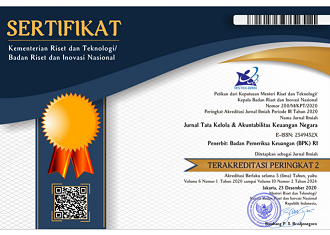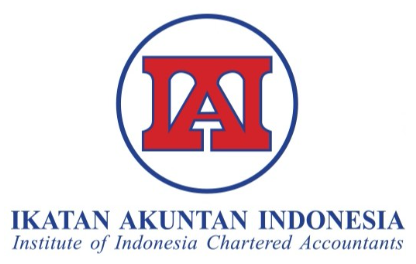Unraveling the impact of social assistance and capital expenditure on poverty rates in Papua's Region
DOI:
https://doi.org/10.28986/jtaken.v9i2.1131Keywords:
poverty rate, social assitance expenditure, capital expenditure, fixed effectAbstract
The Indonesian government has made various efforts to reduce poverty, including through policies in government spending. The spending realized by the government is expected to be able to encourage an increase in people's welfare and reduce poverty. This study aims to analyze the effect of government spending, especially social assistance expenditure and five types of capital expenditure, on the poverty rate, using data at the regional/city level in the Papua province from 2011 to 2019. This study also uses other supporting variables, namely the Gini ratio, Gross per capita Regional Domestic Product (GRDP), school participation rate, and ratio of community health centers. The data used is secondary data obtained from Statistics, The Audit Board of The Republic of Indonesia (Badan Pemeriksa Keuangan, BPK), and the Ministry of Health. The data analysis technique used in this study is panel data regression analysis with a fixed effect model. The analysis showed that out of the six types of government expenditure studied, only capital expenditure for roads, networks, and irrigation significantly reduces the poverty rate.
References
Aji, Y. I. T. (2022). The effect of village income and gross regional domestic product on poverty in Indonesia. Jurnal Bina Praja: Journal of Home Affairs Governance, 14(2), 315–328. https://doi.org/10.21787/jbp.14.2022.315-328
Afandi, A., Wahyuni, D., & Sriyana J. (2017). Policies to eliminate poverty rate in Indonesia. International Journal of Economics and Financial Issues, 7(1), 435-441. https://www.econjournals.com/index.php/ijefi/article/view/3299.
Anderson, E., d’Orey, M. A. J., Duvendack, M., & Esposito, L. (2018). Does government spending affect income poverty? A meta-regression analysis. World Development, 103, March, 60-71. https://doi.org/10.1016/j.worlddev.2017.10.006
Anitasari, M., & Soleh, A. (2015). Pengaruh pengeluaran pemerintah terhadap pertumbuhan ekonomi di Provinsi Bengkulu. Ekombis Review. 3(2). https://doi.org/10.37676/ekombis.v3i2.139.
Babatunde, S. A. (2018). Government spending on infrastructure and economic growth in Nigeria. Economic Research-Ekonomska Istraživanja, 31(1), 997–1014. https://doi.org/10.1080/1331677X.2018.1436453
Bappenas. (2018). Analisis wilayah dengan kemiskinan tinggi. Jakarta: Bappenas.
BPK RI. (2020). Laporan Hasil Pemeriksaan BPK RI Atas Laporan Keuangan Pemerintah Daerah Provinsi Papua Tahun 2019. Jakarta: Badan Pemeriksa Keuangan.
BPS Provinsi Papua. (2020). Statistik kesejahteraan rakyat provinsi papua. https://papua.bps.go.id/publication/2020/12/30/ffa47c170da5e49036f59814/statistik-kesejahteraan-rakyat-provinsi-papua-2020.html
BPS Provinsi Papua. (2021). Data kemiskinan dan ketimpangan, angka partisipasi sekolah dan [Seri 2010] PDRB ADHK (Dengan Tambang) menurut Kabupaten/Kota (Juta Rupiah). https://papua.bps.go.id/indicator/52/382/1/-seri-2010-pdrb-adhk-dengan-tambang-menurut-kabupaten-kota.html
Barro, R. J. (2000). Inequality and growth in a panel of countries. Journal of Economic Growth, 5(1), 5-32. https://doi.org/10.1023/A:1009850119329
Barros, C. P., & Gupta, R. (2017). Development, poverty, and inequality. The Journal of Developing Areas, 51(1), 19-32. https://www.jstor.org/stable/10.2307/26415693Bloom, D. E., Canning, D., & Sevilla, J. (2003). The effect of health on economic growth: A production function approach. World Development, 32(1), 1-13. https://doi.org/10.1016/j.worlddev.2003.07.002
Bourguignon, F. (2004). The Poverty-Growth-Inequality Triangle. The World Bank. https://documents1.worldbank.org/curated/en/449711468762020101/pdf/28102.pdf
Bourguignon, F., & Chakravarty, S. R. (2003). Pengukuran kemiskinan multidimensi. Jurnal Ketimpangan Ekonomi, 1, 25-49. http://dx.doi.org/10.1023/A:1023913831342
Direktorat Jenderal Perimbangan Keuangan Kementerian Keuangan (DJPK). (2017). POSTUR APBD Tahun 2016. Retrieved from https://djpk.kemenkeu.go.id/portal/data/apbd?tahun=2016&provinsi=26&pemda=10
Direktorat Jenderal Perimbangan Keuangan Kementerian Keuangan (DJPK). (2018). POSTUR APBD Tahun 2017. Retrieved from https://djpk.kemenkeu.go.id/portal/data/apbd?tahun=2017&provinsi=26&pemda=10
Direktorat Jenderal Perimbangan Keuangan Kementerian Keuangan (DJPK). (2019). POSTUR APBD Tahun 2018. Retrieved from https://djpk.kemenkeu.go.id/portal/data/apbd?tahun=2018&provinsi=26&pemda=10
Direktorat Jenderal Perimbangan Keuangan Kementerian Keuangan (DJPK). (2020a). POSTUR APBD Tahun 2019. Retrieved from https://djpk.kemenkeu.go.id/portal/data/apbd?tahun=2019&provinsi=26&pemda=10
Direktorat Jenderal Perimbangan Keuangan Kementerian Keuangan (DJPK). (2020b). Ringkasan APBD 2019. Retrieved from https://djpk.kemenkeu.go.id/?p=5412.
Dollar, D., & Kraay, A. (2002). Growth is good for the poor. Journal of Economic Growth, 7(3), 195–225. https://doi.org/10.1023/A:1020139631000
Efrianti, R., Marwa, T., Tarmizi, N., & Yuliana, S. (2018). Growth, unemployment, and its implication on poverty: Empirical study in districts/cities of South Sumatera Province. Eurasia Journal of Economics and Finance, 6(4). https://doi.org/10.15604/ejef.2018.06.04.003.
Krismaningtyas, Y. (2019). Analisis pengaruh belanja modal pemerintah daerah terhadap pananggulangan kemiskinan di Jawa Timur [Unpublished master’s thesis]. Universitas Gadjah Mada, Yogyakarta.
Liu, Y., Amin, A., Rasool, S. A., & Zaman, Q. U. (2020). The role of agriculture and foreign remittances in mitigating rural poverty: Empirical evidence from Pakistan. Risk Management and Healthcare Policy, 1(3), 13-26. https://doi.org/10.2147/rmhp.s235580.
Marinho, E., Campelo, G., Franca, J., & Araujo, J. (2017). Impact of infrastructure expenses in strategic sectors for Brazilian poverty. EconomiA, 18(2), 244-259. https://doi.org/10.1016/j.econ.2017.01.002.
Masnila, N., Lisnini., & Oktanisa, S. (2018). The effect of government capital expenditure on economic growth and its impact on community welfare. The 2nd Forum in Research, Science, and Technology (FIRST 2018). https://doi.org/10.5220/0009153400002500
Nursini, N., & Tawakkal. (2019). Poverty alleviation in the context of fiscal decentralization in Indonesia. Economics and Sociology, 12(1), 270-285. https://doi.org/10.14254/2071-789X.2019/12-1/16.
Psacharopoulos, G., & Patrinos, H. A. (2018). Returns to investment in education: A decennial review of the global literature. Education Economics, 26(5), 445-458.
https://doi.org/10.1080/09645292.2018.1484426
Qurrata, V. A., & Ramadhani, N. (2021). The impact of HDI, minimum wages, investment, and GRDP on poverty in East Java in 2019. KnE Social Sciences, 5(8), 411–418. https://doi.org/10.18502/kss.v5i8.9393
Rarun, C. Ch. E., Kawung, G. M. V., & Niode, A. O. (2018). Analisis pengaruh belanja bantuan sosial dan investasi swasta terhadap kemiskinan di provinsi Sulawesi Utara. Jurnal Berkala Ilmiah Efisiensi, 18(01). https://ejournal.unsrat.ac.id/index.php/jbie/article/view/19824
Ravallion, M. (2001). Growth, inequality, and poverty: Looking beyond averages. World Development, 29(11), 1803-1815. https://doi.org/10.1016/S0305-750X(01)00072-9
Ravallion, M. (2005). Inequality is bad for the poor. The World Bank. https://doi.org/10.1596/1813-9450-3677
Sasmal, R., & Sasmal, J. (2016). Public expenditure, economic growth, and poverty alleviation. International Journal of Social Economics, 43(6), 604-618. https://doi.org/10.1108/IJSE-08-2014-0161.
Sendouw, A., Rumate, V. A., & Rotinsulu, D. C. (2017). Pengaruh belanja modal, belanja sosial, dan pertumbuhan ekonomi terhadap tingkat kemiskinan di Kota Manado. Jurnal Pembangunan Ekonomi dan Keuangan Daerah, 18(5). https://doi.org/10.35794/jpekd.15780.19.2.2017.
Sennoga, E. B., & Matovu, J. M. (2013). Public spending composition in Uganda and its implications for growth and poverty reduction. Public Finance Review, 41(2), 227-247. https://doi.org/10.1177/1091142112448412.
Sheikh, M. R., Akhtar, H. A., Asghar, M. M., & Abbas, A. (2020). Demographic and economic aspect of poverty: A case study of Multan District, Pakistan. Pakistan Economic and Social Review, 58(1), 131-160. https://pesr.econpu.edu.pk/website/journal/article/6055f4ed31f49/page.
Sihombing, P. R., & Arsani, A. M. (2021). Static and dynamic panel models: Which is better? (Case study poverty data in Indonesia 2012-2019). IOP Conference Series: Earth and Environmental Science. https://doi.org/10.1088/1755-1315/739/1/012057.
Silva, I. D., & Sumarto, S. (2015). Dynamics of growth, poverty, and human capital: Evidence from Indonesian sub-national data. Journal of Economic Development, 40(2), 1-33. http://www.jed.or.kr/full-text/40-2/1.pdf.
Sofi, I. (2020). Pemenuhan anggaran infrastruktur di daerah dan tantangannya. https://www.kemenkeu.go.id/publikasi/artikel-dan-opini/pemenuhan-anggaran-infrastruktur-di-daerah-dan-tantangannya/.
Sumiyarti, S. (2022). Pengaruh belaja modal dan belanja bantuan sosial terhadap pertumbuhan ekonomi dan kemiskinan. Srikandi: Journal of Islamic Economics and Banking, 1(1), 28–43. https://doi.org/10.25217/srikandi.v1i1.1547
Todaro, M. S., & Smith S. C. (2014). Economic development (12th ed). Pearson.
Wagle, U. R. (2017). How much do social protections matter to poverty and inequality? An insight from Asian experiences. Global Social Policy, 17(2), 137-167. https://doi.org/10.1177/1468018116675496.
Wooldridge, J. M. (2016). Introductory econometrics: A modern approach (6th ed). Cengage Learning.
World Bank. (2018). World development report 2018: Learning to realize education's promise. https://www.worldbank.org/en/publication/wdr2018
Downloads
Submitted
Accepted
Published
How to Cite
Issue
Section
License
Copyright (c) 2023 Jurnal Tata Kelola dan Akuntabilitas Keuangan Negara

This work is licensed under a Creative Commons Attribution-ShareAlike 4.0 International License.

Jurnal Tata Kelola dan Akuntabilitas Keuangan Negara is licensed under
a Creative Commons Attribution-ShareAlike 4.0 International License




















